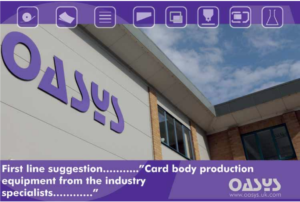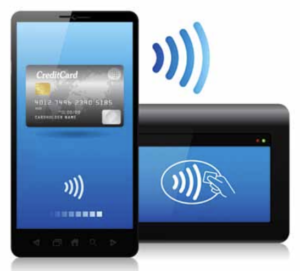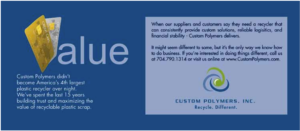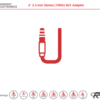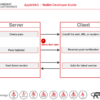Dear Reader,
We hear a constant buzz these days in the card industry about NFC (Near Field Communications). While it is almost always used in the context of a payments application on a smartphone platform, technically NFC is simply a short-range, contactless communication technology. Someone may ask, where does this technology fit in the contactless card universe with its associated set of international Standards?
Historically, contactless card technology has been defined as communication between two devices where one acts as a reader/writer (e.g POS terminal) and the other as a “tag” (e.g. card). The reader/writer is an active device that generates the radio signals (electro-magnetic field) to communicate with the tags. In a passive mode of communication, this field also provides power to the tag. The tag is a passive device that communicates by modulating the electro-magnetic field, thereby sending information back to the reader. If the tag (card) carries its own power supply, it can communicate with the reader/writer in an active mode by alternating signal transmissions with the reader. ISO/IEC 14443 is the international Standard for proximity contactless smart cards. There are four parts that comprise the Standard:
• Part 1: ISO/IEC 14443-1 describes the physical characteristics of these cards
• Part 2: ISO/IEC 14443-2 describes the radio frequency power and signal interface. The primary emphasis is on bit timings, signal waveforms and encoding used for communication. Two distinctly different forms are described; namely, Type A and Type B. Either form is acceptable.
• Part 3: ISO/IEC 14443-3 describes the initialization and anti-collision provisions. This part refers to the data frames and anti-collision techniques used to discover all the cards (tags) in the electro-magnetic field.
• Part 4: ISO/IEC 14443-4 describes the transmission protocol requirements. It provides for an optional protocol referred to as T = CL (contactless) analogous to T = 0, T= 1 protocol options used in smart cards with contacts.
Now, where does NFC fit in here? A cross-industry group known as the NFC Forum has driven the standardization of NFC technology and communication protocol. ISO/IEC18092 (Telecommunications and Information Exchange. Between Systems – Near Field Communications – Interface and Protocol), sometimes referred to as NFCIP-1 (Near Field Communication – Interface and Protocol Specification),is the governing international Standard for this technology.
It is based on ISO/IEC 14443 but has a critical difference. It utilizes a different command protocol to replace Part 4 of ISO/IEC 14443. It also includes two communication modes, active and passive, which allow an NFC device to communicate with other NFC devices in a peer-to-peer mode as well as with ISO/IEC 18092 based NFC tags (cards). Within the two modes of communication there are three modes of operation defined in ISO/IEC 18092:
- Read/Write: In this mode, the NFC enabled phone can read or write data to any of the supported tag types in a standard NFC data format.
- Peer-to-Peer: Two NFC-enabled devices can exchange data. They could share a WiFi or Bluetooth link, for example. Or exchange data in the form of virtual business cards and photos.
- Card-Emulation: While NFC-enabled phones can act as a reader when in contact with tags, in this mode, the phone can also act as a tag (contactless card) for other readers (POS terminals).
Specifically, the NFC Forum states that in card emulation mode, NFC-enabled phones can support the contactless card EMV payment application requirements specified in EMV CCPS v2.0 and embodied by American Express ExpressPay 2.0, MasterCard PayPass 2.0 and Visa payWave 2.1.1. Therefore, if the NFC device operates under the specifications of ISO/IEC 18092 in card emulation mode, it should be interoperable with a reader/writer (POS terminal) that operates under the specifications of ISO/IEC 14443. However, ISO/IEC 18092 also defines a peer-to-peer mode where two devices can exchange data (i.e. a card acting as a reader). There is no such current equivalent defined in ISO/ IEC 14443 and therefore these NFC devices would not be interoperable with devices operating under ISO/IEC 14443.
While mobile payments, NFC technology and NFC enabled smartphones will continue to generate news, our purses and wallets will still have a card that carries the payment information stored in the mobile device. The payment associations are still requiring that a card be issued to every cardholder that loads a branded mobile payment application to an NFC smartphone
About Ambimat Electronics:
With design experience of close to 4 decades of excellence, world-class talent, and innovative breakthroughs, Ambimat Electronics is a single-stop solution enabler to Leading PSUs, private sector companies, and start-ups to deliver design capabilities and develop manufacturing capabilities in various industries and markets. AmbiIoT design services have helped develop Smartwatches, Smart homes, Medicals, Robotics, Retail, Pubs and brewery, Security.
Ambimat Electronics has come a long way to become one of India’s leading IoT(Internet of things) product designers and manufacturers today. We present below some of our solutions that can be implemented and parameterized according to specific business needs. AmbiPay, AmbiPower, AmbiCon, AmbiSecure, AmbiSense, AmbiAutomation.
To know more about us or what Ambimat does, we invite you to follow us on LinkedIn or visit our website

